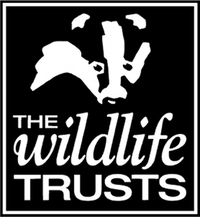Yorkshire Wildlife Trust
 The logo of the Wildlife Trusts | |
| Abbreviation | YWT |
|---|---|
| Formation | 1 January 1946 as Yorkshire Naturalists’ Trust |
| Type | Registered charity No.210807 |
| Legal status | Company limited by guarantee No.409650 |
| Purpose | Protecting wildlife and wild places, and educating, influencing and empowering people. |
| Headquarters | 1 St George's Place, York |
| Location |
|
Region served | Traditional county of Yorkshire |
Chief Executive | Rachael Bice |
| Affiliations | The Wildlife Trusts partnership |
Budget (2017–2018) | £10 million[1] |
| Website | Official website |
The Yorkshire Wildlife Trust is a wildlife trust that covers the Yorkshire and the Humber region of England. When it was founded, it covered the traditional county of Yorkshire, England, but under the 1974 county boundary changes, some of the trust's boundaries were amended to reflect those changes.[2] The Trust is part of the UK-wide partnership of 46 Wildlife Trusts. It was formed in 1946, as the Yorkshire Naturalists’ Trust, essentially to preserve its first nature reserve Askham Bog on the outskirts of York. It now manages more than ninety reserves[3] across the county, including some of the best wildlife sites in the UK. These nature reserves cover the diversity of Yorkshire's landscape, from woodland to grassland, wetland and moorland, fen and bog, and river and coast. One of the flagship reserves is Potteric Carr, a mixed wetland habitat to the south of Doncaster.[4]
This trust offers a membership card that visitors can use to access the below mentioned reserves:[5]
Sites[]
North Yorkshire[]
- Ashberry
- Askham Bog
- Barlow Common
- Bishop Monkton Railway Cutting
- Bolton-on-Swale Lake
- Bolton Percy Station
- Brae Pasture
- Brockadale
- Burton Leonard Lime Quarries
- Burton Riggs
- Chafer Wood
- Ellerburn Bank
- Fen Bog
- Filey Dams
- Garbutt Wood
- Globe Flower Wood
- Grass Wood
- Harland Mount
- Jeffry Bog
- Leyburn Old Glebe
- Little Beck Wood
- Moorlands
- Ripon City Wetlands [6]
- Ripon Loop
- Semer Water
- Sherburn Willows
- South House Pavement
- Southerscales
- Staveley
- Strensall Common
- Upper Dunsforth Carr
- Wharram Quarry
- Weldrake Ings
- Yellands Meadow
East Yorkshire[]

- Allerthorpe Common
- Calley Heath
- Flamborugh Cliffs
- Hodgson's Fields
- Keldmarsh
- Kilnsea Wetlands
- Kiplingcotes Chalk Pit
- North cave Wetlands
- North Cliffe Wood
- North Newbald Becksies
- Paull Holme Strays
- Pearson Park Wildlife Garden
- Pulfin Bog
- Rifle Butts Quarry
- Saltmarshe Delph
- Skerne Wetlands
- Snakeholm Pastures
- Spurn
- Welwick Saltmarsh
South Yorkshire[]
- Brockadale
- Denaby Ings
- Fen Carr
- Hopyard Haymeadow & Owston Meadows
- Maltby Low Common
- Potteric Carr
- Sprotborough Flash
- Thorpe Marsh
(Other Wildlife Trust reserves in South Yorkshire are managed by Sheffield Wildlife Trust.)
West Yorkshire[]
- Adel Dam
- Broadhead Clough
- Hetchell Wood
- Hollinhurst Wood
- Kippax Meadows
- Kirkstall Valley
- Ledsham Bank
- Ledston Luck
- Letchmire Pastures
- Low Wood
- Owl Wood and Pit Plantation
- Rothwell Country Park
- Rothwell Pastures
- Stirley Community Farm
- Stocksmoor Common
- Stoneycliffe Wood
- The Lines Way
- Townclose Hills
- Upper Park Wood
- Water Haigh Woodland Park
- Willow Garth
Controversy at Spurn[]
Yorkshire Wildlife Trust received over 2,800 objections to the erection of a £900,000 visitors' centre on the Spurn Heritage Coast, East Riding of Yorkshire, with residents of neighbouring Kilnsea citing visual impact and flooding among their concerns. The planning application was successful on its second attempt in January 2017, after amendments to the original proposals, but despite ongoing concerns of locals.[7][8]
References[]
- ^ "Annual report and consolidated reports year ended 31 March 2018" (PDF). yet.org.uk. p. 24. Retrieved 5 March 2019.
- ^ "Borthwick Institute for Archives, University of York Finding Aid - Yorkshire Wildlife Trust Archive (YWT)" (PDF). borthcat.york.ac.uk. 25 January 2019. p. 120. Retrieved 5 March 2019.
- ^ "View Find a nature reserve". Yorkshire Wildlife Trust. Retrieved 16 January 2015.
- ^ "Potteric Carr Nature Reserve: Introduction". Friends of Potteric Carr. Archived from the original on 13 August 2011. Retrieved 12 May 2015.
- ^ "Visit". Yorkshire Wildlife Trust. Retrieved 18 January 2017.
- ^ "Ripon City Wetlands". Yorkshire Wildlife Trust. Retrieved 26 September 2020.
- ^ "Spurn gets go-ahead for wildlife visitor centre". BBC News. Retrieved 9 February 2018.
- ^ "Controversial Visitor Centre Unit Arrives". Hull Daily Mail. Retrieved 9 February 2018.
External links[]
- Organisations based in York
- Wildlife Trusts of England
- Organizations established in 1946
- 1946 establishments in England
- Environment of Yorkshire
- English organisation stubs
- Environmental organization stubs